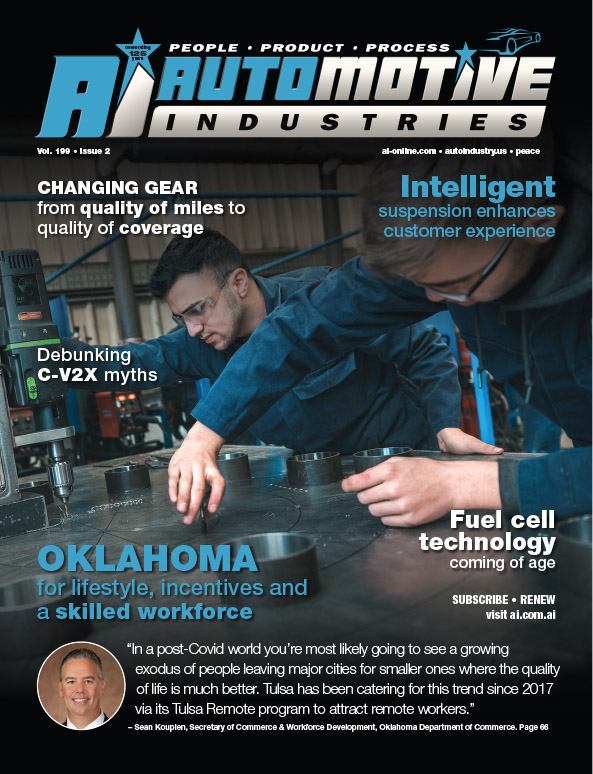

South Central state Oklahoma has hit the “on” switch to attract a new generation of electric automotive companies and plants.
Your Mechanic.com has ranked Oklahoma as the most EV-friendly state to own an electric vehicle. The State has also introduced a number of incentives to attract automotive investment.
The incentives and other support have been fine-tuned in a bid for Tesla’s new Cybertruck Gigafactory.
The bid was so strong that the state made the shortlist, with Tesla finally selecting Austin, Texas. Oklahoma remains open for EV and auto part businesses. “We will actively pursue the supplier base for the Tesla factory to persuade them to locate in our state. Through the bid process we attracted worldwide attention and 116 companies representing a wide range of industries including automotive, aerospace and energy are considering relocation or expansion in our state right now,” says Sean Kouplen, Secretary of Commerce and Workforce Development.
“The comprehensive effort made by the State of Oklahoma, the City of Tulsa and the Tulsa Regional Chamber proves Oklahoma remains open for business and is an ideal destination for the automotive industry,” said Governor Kevin Stitt in a statement released after Tesla announced its decision.
Automotive Industries (AI) asked Kouplen to share some of the benefits of investing in the state.
Kouplen: Our relationship with companies doesn’t stop once they begin operations. If Oklahoma has shown anything during the COVID-19 pandemic, it’s that we support Oklahoma companies. We retooled existing incentive programs to assist Oklahoma companies and spur economic recovery.
Our focus is on the commercialization of new technology and supporting efforts to help Oklahoma businesses get started and grow.
Earlier this year, the Oklahoma Department of Commerce launched a new innovation initiative to increase venture capital in the state and identify barriers to market that are prohibiting start-ups from taking the next steps.
AI: What attracts automotive OEMs to Oklahoma?
Kouplen: Oklahoma is centrally located and accessible by air, rail, road, and water, with the most inland ice-free ports in the U.S. Within a 24-hour drive, you’ll reach every single OEM manufacturing facility in the USA. Oklahoma is also a constitutional Right to Work state with low unemployment insurance taxes and programs, which significantly reduce hiring and training start-up costs.
AI: Has your being shortlisted for the Tesla factory strengthened the state’s appeal as an investment destination for EV manufacturers and component suppliers?
Kouplen: The creativity and ingenuity demonstrated by Oklahomans to gain Elon Musk’s attention was pretty spectacular. We may not have landed the project, but Oklahoma made an impression on automotive companies. Over the past couple of months, we’ve received multiple calls from automotive suppliers wanting to know more about setting up shop in our state.
AI: How do you see the economic future of Oklahoma?
Kouplen: With remote working becoming the new normal in a post-Covid world you’re most likely going to see a growing exodus of people leaving major cities for smaller ones where the quality of life is much better. Tulsa has been catering for this trend since 2017 via its Tulsa Remote program which offers a slew of benefits, including $10,000 to eligible remote workers to settle in Tulsa. There have been nearly 20,000 applications, representing 138 industries, including IT and services, computer software, marketing and advertising, healthcare and consumer services.
AI then asked Jennifer Springer, Director of Business Development, Oklahoma Department of Commerce, about the challenges in attracting new investment.

Springer: This depends on who you’re speaking with. If it is a company outside of the country, the first challenge is simply placing Oklahoma on the map. Once you get past this step, we’re in a fortunate position to be able to offer most companies what they’re seeking: easy access to the U.S. market, lower costs of doing business and – most importantly – a pipeline of qualified workers. If you’re dealing with a U.S. company, the challenge is to get beyond misconceptions people may have about Oklahoma.
AI: What are some of the common misconceptions?
Springer: One of the biggest misconceptions is that we have no quality of life. Time and time again executives who have moved to Oklahoma from coastal states like California and Virginia (such as the employees of Boeing and Verizon) have been pleasantly surprised by the lifestyle that Oklahoma has to offer. Benefits include affordable housing, great schools and universities, a vast array of outdoor activities and cultural offerings, as well as a wide selection of restaurants. In order to change perceptions, we capture the experiences of people who have moved to the state on video and share this across our social networks and with prospective investors.
AI: What is the Automotive Workforce Engineer Tax Credit.
Springer: Oklahoma offers tax credits to automotive companies hiring engineers in a variety of fields that equal 5% of the compensation paid to an engineer and 10% if the engineer graduated from an Oklahoma college or university. Another credit of up to 50% of the tuition cost is reimbursed to an employee. Automotive companies can offer this incentive as a recruiting tool to the employees they bring to Oklahoma, as the engineers they hire would also receive a $5,000 tax credit per year.
AI: How effective have the worker tax credits been in attracting companies?
Springer: Our Automotive Workforce Engineer Tax Credit is modelled on the Aerospace Engineer Tax Credits which were instrumental in attracting companies such as Boeing, ASCO Industries, Ferra Aerospace, Lufthansa Technik, Mitsubishi, Kratos Defense, Rolls Royce Engines, Northrop Grumman, Pratt & Whitney, American Airlines, and Frontier Electronics.
AI: What other incentives are there for automotive companies?
Springer: There are a number. Our successful Quality Jobs incentive program provides a cash rebate to companies that create well-paid jobs and promote economic development. The state’s Investment/New Jobs Tax Credits provide growing manufacturers a significant tax credit based on either an investment in depreciable property or on the addition of full-time-equivalent employees engaged in the manufacturing process. There’s also the Business Expansion Incentive Program, which assists Oklahoma companies making major capital investments in depreciable items like machinery, equipment and buildings. These are in addition to other incentives which include five-year ad valorem tax exemption, customized employee training, and multiple local financing programs and incentives.
AI: Tell us about how Oklahoma is expanding the supply of workers with skills sought by automotive companies?
Springer: Being able to draw from a pipeline of qualified workers has been one of the key drivers for companies to located in Oklahoma. Firstly, Oklahoma CareerTech, with more than 7,500 enrolments annually, offers training aligned with automotive workforce demand. Courses include ASE technician, CNC, machinist, diesel service, metal fabrication, electronics and welding.
Secondly, the state’s workforce training program customizes solutions for investors to meet their skilled labor needs. From pre-employment, industry-specific and customized training, the state integrates various work-based learning experiences (including German apprenticeship-like programs) with its industry-aligned curricula to create a pipeline of workers for current and future needs.
Third, the Oklahoma Center for the Advancement of Science and Technology (OCAST) has established a program that places qualified interns within companies.
Finally, two of the state’s key industry sectors, aerospace and oil and gas, each employ 120,000 workers. This offers a pool of skills and knowledge that can easily be adapted to meet the needs of auto manufacturers.



More Stories
Auto Repair Services: Keeping Your Vehicle Road-Ready
Unleashing Creativity with Vidnoz: The Best Free AI Video Generator in 2025
The Connection Between Air Drying and Energy Efficiency in Industrial Settings